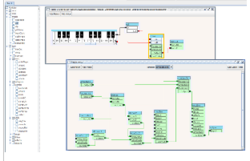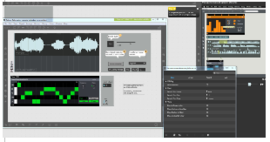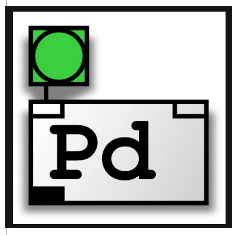In the World of Grains – Part 4 (contains embedded video)

In the World of Grains – Part 4
(contains embedded video) If you want to support my work, please make use of the "PayPal" button - thank you very much indeed!
Computer Languages with Graphical User Interfaces
Syntona
Syntona is the graphical user interface of the (Java based) language Jsyn (see last chapter).
To say it right at the beginning: You can do a lot more with the language Jsyn than you can do using its UI Syntona, and if you are only aiming for granular sound processing, well, don´t dive into Syntona then.
And there is another downside: You won´t find a lot of information and material about JSyn, and even less about Syntona on the Internet.
But if you are a bit familiar with Java, and if you don´t mind leaving the graphical user interface, and jumping to the “mother-language” JSyn from time to time, then you will like Syntona quite a lot, because it comes with a well made, and easy to use help system (easy to use for people with at least a bit of Java experience).
Syntona allows building layered structures, with each layer having its own window, where you can specify the behaviour of a component in the mother-window in more details. (see linked video).
Syntona comes with some pre-build modules, like different oscillators, filters, math modules, controllers etc., but there are a lot of modules missing, which I´d like to have pre-built (like e.g. a simple LFO), so that there weren´t the need to built them on my own.
On the other hand there is this powerful JSyn language running in the background, which enables real deep and detailed manipulations of sound.
Syntona and Jsyn are free for personal and academic use. The most up-to date version (now, 05/19/2020) is V0.5.22 Build 49 from 10/16/2019. As a couple of new versions have been released each year so far, I hope for more and more pre-built modules in the future.
MAX/MSP
Who would not have at least heard about MAX (it runs on PC/Windows as well as on MAC, but not on Linux)!
Users of Ableton´s most expensive version of Live will even have used it, as it is included there as “Max4Live”.

And less dedicated users of PD (PureData, see next part) may be yearning for its nice looks.
So, what is it, that makes this commercial software seem to be the number one among the visual programming languages, which deal with (not only) sound?
First of all: MAX is (nearly) complete, there isn´t (nearly) anything you cannot do with sound using MAX.
Then there is a great and easy to use documentation. Max includes Jitter, to work with video and graphics.
There is a huge number of pre-coded “macroscopic” objects to be used in your code/patches.
Max is regularly updated (the most up-to date version is Version 8, now in May 2020).
Since version 8 MAX is NODE compatible, and accepts .JS (you know, these things you use when you do some backend coding, client-server stuff etc.). This means you can directly interact with your operating system and with the Internet out of a MAX patch
And Max looks good.
So, all in all you don´t risk wasting time and energy by starting to study MAX, only to discover, that the things you wanted to do cannot be achieved by using MAX – they certainly can (I´m talking about sound and music, of course).
And even communicating with hardware equipment isn´t anything that would give Max a hard time. Max is a compatibility champion.
Aren´t there any negative points to mention?
Well, there are, and it´s not only the price of about 400 dollars for a full license (now in May 2020).
Max doesn´t run on Linux (as mentioned above).
It´s legally difficult, if not impossible, to use MAX/MSP in your own built commercial applications, not for free at least.
You cannot use MAX in a DAW other than Ableton Live (using MAX in a DAW is only one of a thousand ways to use this language/software of course).
Those, who are willing and able to do some deep tweaking in software may miss the ability to change the source code (sometimes a bit of a pity, if you come upon a bug, and have to report it, and then wait for the company to solve the problem in the next version – hopefully), as they´ll do with open source products.

Pure Data
The open source language Pure Data (PD) is very similar to Max/MSP in structure and in its scope, but is far more than just a freeware copy of Max. You can even export (and import) patches to Max/MSP.
PD runs on Windows, on Mac OSX, and on Linux.
PD exists in some slightly different versions. The one, which is often and regularly updated and developed (several times a year) is called the “Vanilla” version, current release 0.50-2 (now in May 2020).
Let´s look at the other differences to Max/MSP.
PD has less pre-coded objects, that come with the download than Max/MSP has – but there is a huge and extremely active community around it, which never gets tired of developing additions to PD. You just have to research for them and to download them separately. And if you are familiar to one of the languages C, C++ or Fortran, you can build your own specific objects, and integrate them in your version of PD.
Concerning numbers in PD we have only floating-point numbers, whereas Max/MSP knows both, floating-point as well as real integer (well, if it is important for the matter of this book).
Please have a look at file:///C:/Program%20Files%20(x86)/Pd/doc/1.manual/x5.htm#s3 in the HTML manual of PD for some smaller differences in syntax and behaviour of the software.
There is a whole universe of free patches made by PD users available on the Internet, and this active community is always ready to help. Please see the Resources chapter at the end of this book.
Just to mention it: PD can also deal with video and images ( using GEM – Graphics Environment for Multimedia, as opposed to GEM – Graphics Environment for Max).
The help system of PD is good, but not as good and easy to use as in Max/MSP. You may have to go for one of the community pages to find the solution to a more complex problem from time to time.
PD doesn´t look as nice as Max/MSP though.
And a personal opinion at the end: I think, that PD is a bit easier to get into, and to get going than Max/MSP, when you are a complete beginner in making sound processing software. But again: this is only my personal opinion.
to be continued.
to part 1: ("A Short History of Granular Synthesis - Part 1"):https://www.dev.rofilm-media.net/node/340
to part 2: ("A Short History of Granular Synthesis - Part 2"): https://www.dev.rofilm-media.net/node/342
to part 3: ("A Short History of Granular Synthesis - Part 3"): https://www.dev.rofilm-media.net/node/346
to part 4: ("A Short History of Granular Synthesis - Part 4"): https://www.dev.rofilm-media.net/node/356
to part 5 ("In the World of Grains - Part 1"): https://www.dev.rofilm-media.net/node/364
to part 6 ("In the World of Grains - Part 2"): https://www.dev.rofilm-media.net/node/373
to part 7 (“In the World of Grains – Part 3”): https://www.dev.rofilm-media.net/node/378
to "In the World of Grains" part 5: https://www.dev.rofilm-media.net/node/390
to "In the World of Grains" part 6: https://www.dev.rofilm-media.net/node/398
to "In the World of Grains" part 7: https://www.dev.rofilm-media.net/node/407
to "In the World of Grains" part 8: https://www.dev.rofilm-media.net/node/414
to "in the World of Grains" part 9: https://www.dev.rofilm-media.net/node/421

Add new comment